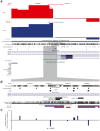Cytosine methylation dysregulation in neonates following intrauterine growth restriction
- PMID: 20126273
- PMCID: PMC2811176
- DOI: 10.1371/journal.pone.0008887
Cytosine methylation dysregulation in neonates following intrauterine growth restriction
Abstract
Background: Perturbations of the intrauterine environment can affect fetal development during critical periods of plasticity, and can increase susceptibility to a number of age-related diseases (e.g., type 2 diabetes mellitus; T2DM), manifesting as late as decades later. We hypothesized that this biological memory is mediated by permanent alterations of the epigenome in stem cell populations, and focused our studies specifically on DNA methylation in CD34+ hematopoietic stem and progenitor cells from cord blood from neonates with intrauterine growth restriction (IUGR) and control subjects.
Methods and findings: Our epigenomic assays utilized a two-stage design involving genome-wide discovery followed by quantitative, single-locus validation. We found that changes in cytosine methylation occur in response to IUGR of moderate degree and involving a restricted number of loci. We also identify specific loci that are targeted for dysregulation of DNA methylation, in particular the hepatocyte nuclear factor 4alpha (HNF4A) gene, a well-known diabetes candidate gene not previously associated with growth restriction in utero, and other loci encoding HNF4A-interacting proteins.
Conclusions: Our results give insights into the potential contribution of epigenomic dysregulation in mediating the long-term consequences of IUGR, and demonstrate the value of this approach to studies of the fetal origin of adult disease.
Conflict of interest statement
Figures



Comment in
-
Stem cell DNA methylation: a consequence of intrauterine growth restriction.Epigenomics. 2010 Jun;2(3):359-60. doi: 10.2217/epi.10.25. Epigenomics. 2010. PMID: 22121897 No abstract available.
Similar articles
-
Experimental intrauterine growth restriction induces alterations in DNA methylation and gene expression in pancreatic islets of rats.J Biol Chem. 2010 May 14;285(20):15111-15118. doi: 10.1074/jbc.M109.095133. Epub 2010 Mar 1. J Biol Chem. 2010. PMID: 20194508 Free PMC article.
-
DNA hypermethylation of CD3(+) T cells from cord blood of infants exposed to intrauterine growth restriction.Diabetologia. 2016 Aug;59(8):1714-23. doi: 10.1007/s00125-016-3983-7. Epub 2016 May 17. Diabetologia. 2016. PMID: 27185256
-
Identification of differentially methylated candidate genes and their biological significance in IUGR neonates by methylation EPIC array.J Matern Fetal Neonatal Med. 2022 Feb;35(3):525-533. doi: 10.1080/14767058.2020.1727881. Epub 2020 Feb 24. J Matern Fetal Neonatal Med. 2022. PMID: 32091279
-
Intrauterine Growth Restriction Alters the Genome-Wide DNA Methylation Profiles in Small Intestine, Liver and Longissimus Dorsi Muscle of Newborn Piglets.Curr Protein Pept Sci. 2019;20(7):713-726. doi: 10.2174/1389203720666190124165243. Curr Protein Pept Sci. 2019. PMID: 30678618 Review.
-
Utility of DNA methylation to assess placental health.Placenta. 2018 Apr;64 Suppl 1:S23-S28. doi: 10.1016/j.placenta.2017.12.013. Epub 2017 Dec 14. Placenta. 2018. PMID: 29273273 Review.
Cited by
-
Genome-wide DNA methylation analysis reveals phytoestrogen modification of promoter methylation patterns during embryonic stem cell differentiation.PLoS One. 2011 Apr 29;6(4):e19278. doi: 10.1371/journal.pone.0019278. PLoS One. 2011. PMID: 21559447 Free PMC article.
-
Gene-environment interactions controlling energy and glucose homeostasis and the developmental origins of obesity.Physiol Rev. 2015 Jan;95(1):47-82. doi: 10.1152/physrev.00007.2014. Physiol Rev. 2015. PMID: 25540138 Free PMC article. Review.
-
Molecular mechanisms underlying the fetal programming of adult disease.J Cell Commun Signal. 2012 Aug;6(3):139-53. doi: 10.1007/s12079-012-0165-3. Epub 2012 May 24. J Cell Commun Signal. 2012. PMID: 22623025 Free PMC article.
-
Adult monozygotic twins discordant for intra-uterine growth have indistinguishable genome-wide DNA methylation profiles.Genome Biol. 2013 May 26;14(5):R44. doi: 10.1186/gb-2013-14-5-r44. Genome Biol. 2013. PMID: 23706164 Free PMC article.
-
Epigenetic Mechanisms Responsible for the Transgenerational Inheritance of Intrauterine Growth Restriction Phenotypes.Front Endocrinol (Lausanne). 2022 Mar 31;13:838737. doi: 10.3389/fendo.2022.838737. eCollection 2022. Front Endocrinol (Lausanne). 2022. PMID: 35432208 Free PMC article. Review.
References
-
- Barker DJ. The origins of the developmental origins theory. J Intern Med. 2007;261:412–417. - PubMed
-
- Barker DJ. The developmental origins of adult disease. J Am Coll Nutr. 2004;23:588S–595S. - PubMed
-
- Jaquet D, Gaboriau A, Czernichow P, Levy-Marchal C. Insulin resistance early in adulthood in subjects born with intrauterine growth retardation. J Clin Endocrinol Metab. 2000;85:1401–1406. - PubMed
-
- Ravelli AC, van der Meulen JH, Michels RP, Osmond C, Barker DJ, et al. Glucose tolerance in adults after prenatal exposure to famine. Lancet. 1998;351:173–177. - PubMed
Publication types
MeSH terms
Substances
Grants and funding
- GM007288/GM/NIGMS NIH HHS/United States
- R37 AG018381/AG/NIA NIH HHS/United States
- HD044078/HD/NICHD NIH HHS/United States
- P30 DK020541/DK/NIDDK NIH HHS/United States
- P60 DK020541/DK/NIDDK NIH HHS/United States
- T32 GM007288/GM/NIGMS NIH HHS/United States
- AG18381/AG/NIA NIH HHS/United States
- R01 HG004401/HG/NHGRI NIH HHS/United States
- HG004401/HG/NHGRI NIH HHS/United States
- P01 AG021654/AG/NIA NIH HHS/United States
- AG21654/AG/NIA NIH HHS/United States
- R01 HD044078/HD/NICHD NIH HHS/United States
- R01 AG018381/AG/NIA NIH HHS/United States
LinkOut - more resources
Full Text Sources
Other Literature Sources
Molecular Biology Databases

